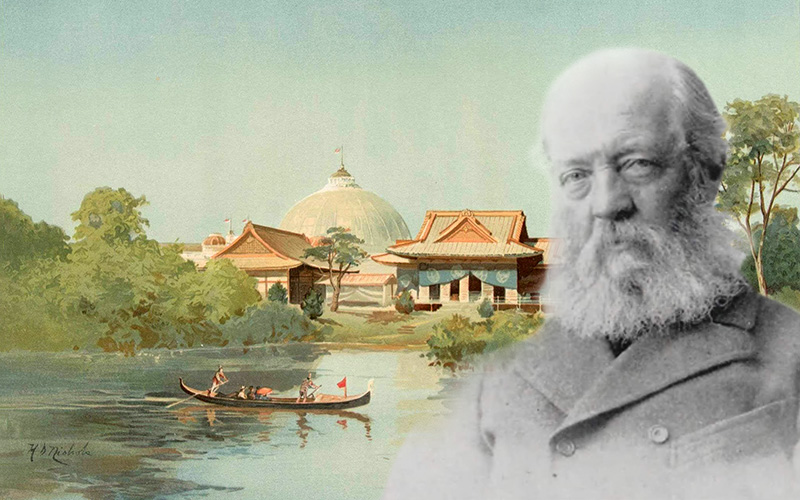
Today is the 200th anniversary of the birth of Frederick Law Olmsted—landscape architect, author, conservationist, and social activist. His ambitious designs transformed Jackson Park in Chicago into the fairgrounds of the 1893 World’s Columbian Exposition in Chicago.
The excerpt below, from the November 1, 1893, issue of the Chicago Inter Ocean newspaper, is quick to credit the many important architects who together designed the fairgrounds. From Olmsted’s seminal vision, though, emerged the Dream City on Lake Michigan. [The article has been lightly formatted and edited for standard capitalization and punctuation.]
For more information on the bicentennial celebration of FLO, visit https://olmsted200.org/.
THE WHITE CITY
———–
Conception and Development of the Dream
———–
OLMSTED’S GRAND BASIN
———–
It Was an Inspiration to the Architects
———–
They Sacrificed Individually to Harmony and Developed the Dream City
The White City!
Where is the master mind that gave this beautiful vision to the world?
Twenty-five millions of people have asked this question millions of times. These millions of people have agreed that this dream city is the artistic triumph of the age, and they have sought for the master mind to whom was first revealed this vision. This master mind was not that of a prophet of divine attributes. It was a composite mind in which were united the genius and the inspiration of many minds.
It is the triumph of art, and the White City will live when men who created it are forgotten. Men realized this in the beginning, and there will be no heart burning as they see their creation pass again into the realm of shadowy things to glow with immortal life with scarcely the name of a man remembered. As Chicago united every effort to make The Fair a glory to the city, so the architects and artists united to make the White City the glory of their art and not of individuals. The work was begun on the idea that there should be self-abnegation among all the builders and that individuality should sink into a common force to uplift American art to a place that would rival even the dreams of Greece and Rome.
America has been crowned with this new and beautiful diadem because the sons of America had the patriotism and unity of purpose to work for their country and their art rather than for themselves. The development of the architecture and art of The Fair shows this when it is followed in detail.
The designers and builders of this dream city were:
F. L. Olmsted
Henry Sargent Codman
John W. Root
Daniel H. Burnham
These men formed the first consulting board as landscape architects and architects. Then came the ten forms of architecture and the architect of the Art palace:
Richard M. Hunt
McKim, Mean & White
Peabody & Stearns
George B. Post
Van Brunt & Howe
Adler & Sullivan
Burling & Whitehouse
Henry Ives Cobb
S. S. Beman
W. L. B. Jenney
Charles B. Atwood.
Roll this combination of genius into one and you have the master mind that created the White City.
Olmsted & Company’s plan of Jackson Park from 1870. [Image from the Chicago Inter Ocean Nov. 1, 1893.]
An Old Map
When Jackson Park was finally selected as the site, the World’s Columbian Exposition company appointed Messrs. F. L. Olmsted & Co. as consulting landscape architects. This act was on Aug. 20, 1890. The ground selected was a marsh partially covered by water, with a ridge through a part of it, on which grew a few scraggy oak trees. Never was a site for a city selected which called louder for the landscape architect than did this.
But Mr. Olmsted had been the landscape architect of the South Parks from the time they were laid out, and in his desk were plans for the improvement of this marsh when Chicago people would tax themselves for the improvement. These plans were brought out and there were found lagoons, the canals, and the Wooded Island practically as they are to-day.
The old landscape architect laid out his original plans before the Committee on Buildings and Grounds as his first and final suggestion for a scheme of land and water in the Columbian Exposition. It was an idea that had been born years before, and it came like a vision that was almost beyond the hope of realization. But the Chicago that had built into a great commercial city on a site almost as discouraging was the way clearer in 1890 to develop the scheme that had been only a dream to an artist in 1870. That ground and water plan for Jackson Park became the scheme for the landscape of the White City.
The only modifications necessary were for the purpose of placing the buildings in position, and these were more simple than many believed, when other practical dreamers came upon the scene in the person of architects. The firm Burnham & Root was selected and appointed as consulting architects Sept. 2, 1890, and then architects in wood and stone and architects in landscape began to study the plans together to find a building scheme and realize the ideal city of art.
The first plan presented by Olmsted and Codman, Burnham and Root to the Grounds and Building Committee on December 1, 1890. [Image from the Chicago Inter Ocean Nov. 1, 1893.]
The Land and Water Scheme
Messrs. Burnham & Root and Olmsted and Codman were recognized as a consulting board by the Committee on Buildings and Grounds. They studied Mr. Olmsted’s scheme of land and water only with the view to finding space for the World’s Fair buildings, and by marking off a number of spaces on the land they found that these buildings could easily be accommodated, and, they believed, with much advantage in the way of adornment of the grounds.
The first plan that went to the Committee on Buildings and Grounds was therefore the plat of Mr. Olmsted with half a dozen big square spaces marked off showing where the main buildings could be located. It had in it the suggestions for only the accommodation of The Fair as to space with the adornment of artistic grounds. These spaces were marked with the names that are now borne by the principal buildings, but they were in no order that would suggest the wonderful grouping of structures that afterward appeared to suggest the name of the Dream City.

